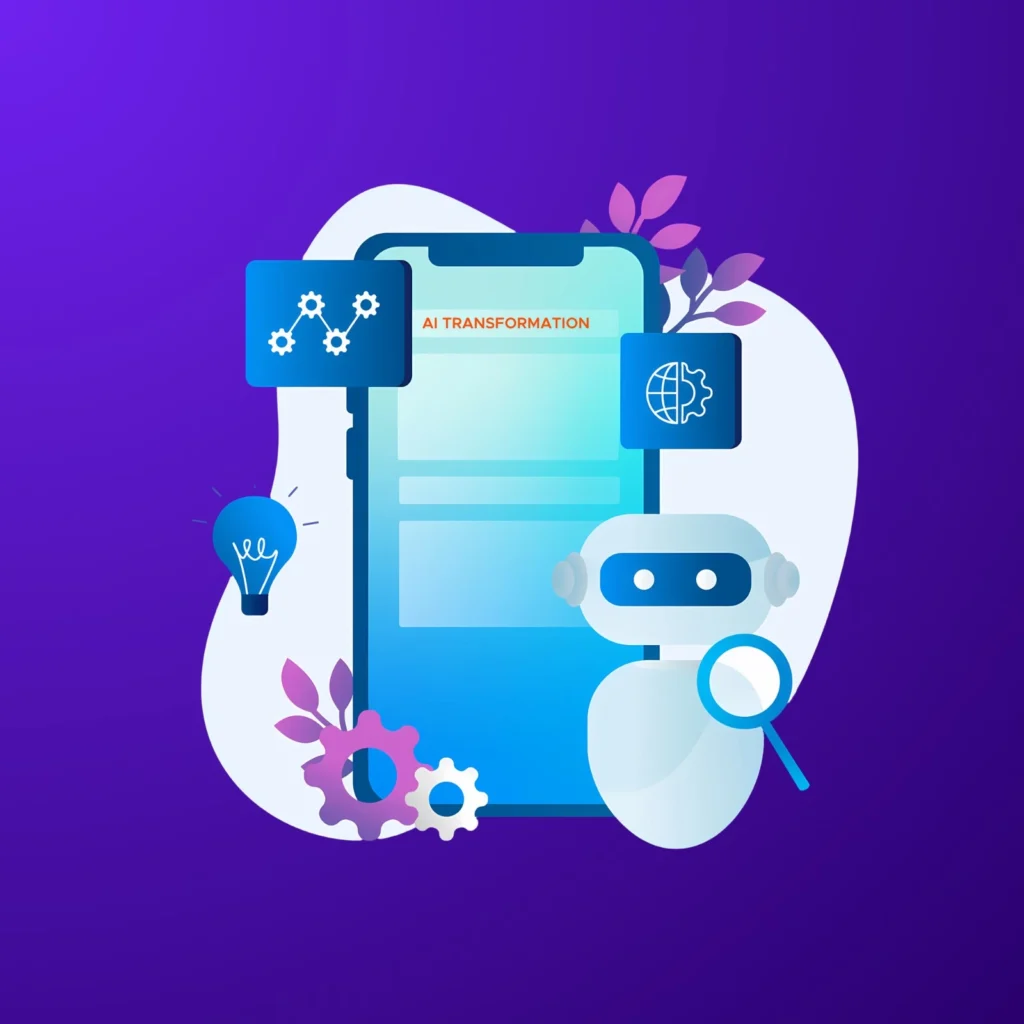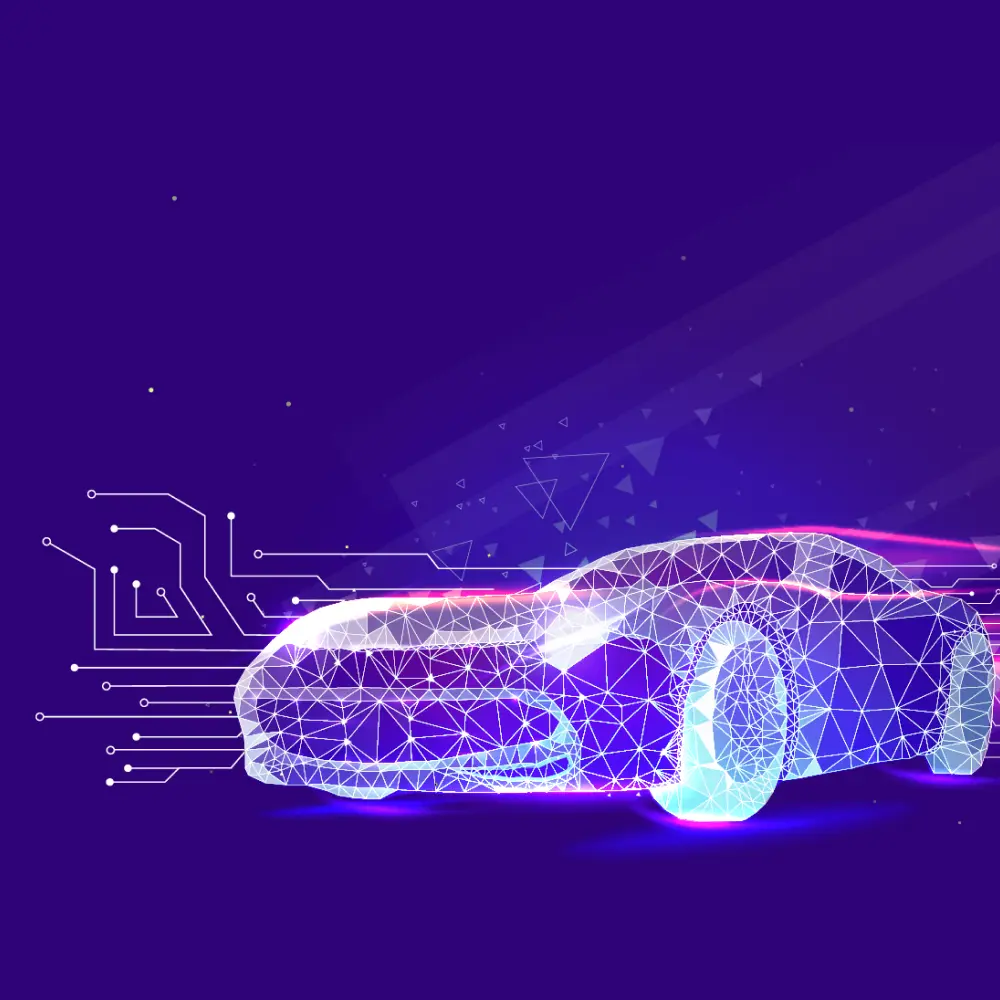In a world where movies depict AI as the future, and visionary leaders forecast machines reaching human-level intelligence, the automotive industry stands on the brink of a profound transformation.
AI has become a driving force in revolutionizing the automotive industry. From manufacturing to vehicle operation and customer experience, AI is reshaping every aspect of the automotive sector. AI technologies such as ML, computer vision, NLP, and robotics are being applied to enhance safety and efficiency in vehicles. This includes predictive maintenance, personalized in-car experiences, and smart manufacturing processes. The integration of AI is not only improving the performance of vehicles but also transforming how consumers interact with automobiles.
The traditional car buying experience often involves time-consuming visits to multiple dealerships. Customers may feel overwhelmed by the multitude of choices available. The negotiation process can be daunting, leading to a less-than-ideal experience. The lack of transparent pricing information can add further stress to the process. By leveraging AI, automotive companies can offer consumers a seamless online journey.
AI in Automotive Industry
AI-powered virtual showrooms and configurators allow potential buyers to explore vehicles in immersive environments. These virtual platforms utilize advanced computer vision and rendering techniques to provide realistic representations of vehicles. This simplifies the browsing process. Recommendation engines play a crucial role in guiding consumers through the overwhelming array of options available. By analyzing customer preferences, behaviour, and historical data, these engines provide personalized recommendations to users. Whether it’s suggesting suitable vehicle models, features, or financing options, AI ensures that customers receive timely guidance.
AI chatbots and virtual avatars address customer queries, providing product information, and facilitating transactions in real-time. These AI-powered assistants are available 24/7, ensuring a seamless customer experience.
Chatbots or Avatars? How to choose the right AI companion for your business? Click here
Importance of Enhancing Virtual Vehicle Buying Experience
Enhancing the virtual vehicle buying experience holds importance for automotive companies and consumers:
- Convenience: Improving the virtual buying experience offers consumers the convenience of exploring vehicles from the comfort of their own homes. This eliminates the need for multiple visits to physical dealerships.
- Efficiency: Streamlining the virtual buying process reduces friction points, such as paperwork, negotiation, and waiting times. This leads to an efficient experience for both consumers and automotive companies.
- Risk Reduction: Virtual showrooms and configurators allow consumers to explore different vehicle options and features in detail before making a purchase. This reduces the risk of buyer’s remorse.
- Adaptation to Changing Consumer Behaviour: As more consumers embrace online shopping, enhancing the virtual vehicle buying experience becomes essential for automotive companies.

A. Personalized Recommendations with AI-powered bots
AI-powered avatars and chatbots engage with consumers in natural language conversations. By understanding each consumer’s preferences and requirements, these virtual assistants offer personalized recommendations. Through virtual demonstrations, AI-powered bots facilitate immersive exploration of vehicles. This enhances the shopping experience by providing an interactive way to explore and compare vehicles.
AI-powered avatars and chatbots are available 24/7 to assist consumers with inquiries, questions, and concerns in real-time. Whether it’s providing information about specific vehicle models, assisting with financing options, or scheduling test drives, these virtual assistants offer immediate support.
AI-powered avatars and chatbots can provide nudges and predictive recommendations based on historical data. For example, if a consumer has been searching sedans, the virtual assistant may suggest similar models or highlight relevant promotions. By proactively guiding consumers towards suitable options, these nudges can help increase the likelihood of a successful purchase.
B. Immersive Virtual Showrooms with Augmented Reality
- Realistic Visualizations: AR enables the creation of highly realistic 3D models of vehicles. This allows consumers to view and interact with lifelike representations of models. By overlaying digital images onto real-world environments, virtual showrooms provide an experience that resembles the physical showroom experience.
- Interactive Customization: AR-powered virtual showrooms allow consumers to customize vehicles in real-time. Exploring different colour options, interior configurations, and accessory packages with a simple tap or swipe becomes possible.
- Spatial Visualization: AR-powered showrooms place virtual vehicles within the physical space of the consumer’s surroundings. This allows consumers to visualize how the vehicle would look and fit in their garage or driveway, providing valuable insights into size, scale, and spatial requirements.
- Engaging Product Presentations: AR enables dynamic product presentations that showcase key features and highlights of vehicles in an engaging manner. These showrooms provide comprehensive product information in a visually compelling format.
- Social Sharing and Collaboration: These showrooms allow consumers to share information with friends and family through collaborative virtual spaces. Social engagement enhances the buying experience and encourages community interaction around the vehicle brand.
C. Virtual test drives and demonstrations
Virtual test drives leverage VR to simulate realistic driving experiences in virtual environments. By wearing VR headsets, consumers can immerse themselves in lifelike driving scenarios, including city streets, highways, and off-road trails. Virtual demonstrations enable consumers to explore the features of vehicles through interactive digital experiences. By eliminating the need for travel and scheduling appointments, virtual drives enable consumers to explore vehicles at their own pace.
Through chatbots or avatars consumers can ask questions, seek clarification, and receive personalized guidance. Virtual test drives contribute to reducing the environmental impact associated with traditional test drives, such as fuel consumption and vehicle emissions. Automotive companies can minimize the need for resource consumption, aligning with sustainability goals.
Benefits of AI-powered Virtual Buying Experience
AI in automotive industry offers a multitude of benefits for both consumers and automotive companies, including:
- Increased Convenience and Efficiency: By enabling consumers to explore vehicles from the comfort of their own homes, AI-powered experiences eliminate the need for multiple visits to physical dealerships. The streamlined online process allows consumers to browse inventory and customize options reducing friction points.
- Personalized Recommendations: AI algorithms analyze consumer data, preferences, and behaviour to provide personalized recommendations. AI-powered systems can suggest relevant vehicle options, features, and financing solutions that align with each consumer’s requirements.
- Convenience and Time-saving for Customers: The convenience of browsing and customizing vehicles online saves customers valuable time and effort.
- Ability to Reach a Wider Audience through Online Platforms: AI-powered virtual buying experiences expand access to vehicle exploration opportunities by reaching a wider audience. Automotive companies can engage consumers across geographic locations, increasing brand visibility and market reach.
AI in Automotive Industry: Overcoming Challenges
A. Connectivity issues and technology limitations
While AI in automotive industry offers numerous benefits, they also face some challenges. Addressing these challenges is essential to ensure a seamless virtual experience for consumers.
- Improving Network Infrastructure: Connectivity issues, such as slow internet speeds or unreliable network connections, can hinder the performance of AI-powered virtual buying platforms. Automotive companies can collaborate with internet service providers to improve network infrastructure.
- Optimizing Platform Compatibility: AI-powered virtual buying platforms must be compatible with a wide range of devices, operating systems, and browsers to reach a diverse audience. Automotive companies can optimize platform compatibility across smartphones, tablets, laptops, desktops and VR headsets.
- Enhancing User Experience: Poorly designed user interfaces and complex navigation can frustrate consumers and undermine the effectiveness of AI-powered virtual buying platforms. Automotive companies should prioritize intuitive design principles, streamline navigation paths, and provide bot support to guide consumers.
- Mitigating Data Privacy Concerns: AI-powered virtual buying experiences rely on consumer data to deliver personalized recommendations. But concerns about data privacy and security can undermine consumer trust and adoption. Automotive companies must implement robust data protection measures and comply with relevant regulations such as GDPR or CCPA.
- Investing in Technology Development: As AI continues to evolve, automotive companies must invest in ongoing research and development to enhance the capabilities of platforms. This may involve collaborating with AI partners and adopting emerging technologies.
B. Integration with existing processes
Integrating AI-powered virtual buying experiences with existing processes presents several challenges that need to be navigated effectively:
- Organizational Resistance to Change: Resistance to change within organizations can pose a significant barrier to the successful integration of AI-powered virtual buying experiences. Internal stakeholders may be reluctant to adopt new technologies or modify existing processes, fearing job displacement or disruptions to established workflows.
- Complexity of Business Processes: Automotive sales processes are often complex and multifaceted, involving multiple stakeholders, departments, and touchpoints throughout the customer journey. Integrating AI-powered virtual buying platforms with existing business processes requires careful coordination and alignment across various organizational functions.
- Data Silos and Fragmentation: Data silos and fragmentation within organizations can impede the seamless integration of AI with existing systems. Disparate data sources, inconsistent data formats, and siloed information repositories may hinder the flow of data and inhibit the ability to derive actionable insights and recommendations from AI-driven technologies.
How to Overcome This?
To address these challenges and facilitate the integration of AI with existing processes, automotive companies can implement the following strategies:
- Conduct Comprehensive Assessments: Conduct thorough assessments of existing systems, processes, and infrastructure to identify potential integration challenges and areas for improvement. Develop a clear understanding of organizational needs, constraints, and priorities to inform integration strategies effectively.
- Invest in Interoperability Solutions: Invest in interoperability solutions and middleware platforms that facilitate seamless data exchange between AI-powered virtual buying platforms and existing systems. Implement standardized APIs, data protocols, and integration frameworks to ensure compatibility and interoperability across different platforms.
- Foster Collaboration and Communication: Foster collaboration among cross-functional teams and departments to align goals, priorities, and expectations regarding the integration of AI-powered virtual buying experiences. Encourage open dialogue, feedback, and knowledge sharing to facilitate a collaborative approach.
- Provide Training and Support: Provide comprehensive training programs and support resources to empower employees with the necessary knowledge to effectively utilize AI in automotive industry. Offer ongoing training, coaching, and mentoring to facilitate continuous learning and skill development.
- Iterative Implementation and Continuous Improvement: Adopt an iterative approach to implementation that allows for incremental changes and continuous improvement over time. Monitor performance metrics, gather feedback from stakeholders, and iterate on integration strategies to address challenges, optimize processes, and enhance the effectiveness of new solutions.
C. Addressing customer concerns and doubts
Addressing customer concerns and doubts is crucial for the successful adoption and acceptance of AI in automotive industry. Some common concerns that automotive companies need to address include:
- Privacy and Security: Customers may be apprehensive about sharing personal information on virtual platforms due to concerns about data privacy and security. It’s essential to implement robust data protection measures, such as encryption, secure authentication, and compliance with privacy regulations.
- Reliability and Accuracy: Customers may question the reliability and accuracy of AI-powered virtual buying platforms. Automotive companies should transparently communicate the capabilities and limitations of AI technologies.
- Lack of Human Interaction: Some customers may prefer face-to-face interactions with sales representatives and may feel uncomfortable engaging with AI. Automotive companies can offer personalized support through live chat or virtual assistants, providing a human touch to enhance the experience.
- Complexity and Usability: Customers may find AI-powered virtual buying platforms complex or difficult to navigate, leading to frustration and dissatisfaction. It’s essential to design user-friendly interfaces and intuitive navigation flows to simplify the user experience and minimize usability barriers. Providing tutorials, guides, and online support resources can also help customers feel more confident using virtual buying platforms.
- Risk of Making Wrong Decisions: Customers may worry about making wrong decisions when using AI in automotive industry. Automotive companies can address this concern by offering educational resources, comparison tools, and interactive features that empower customers to make informed decisions.
How to Overcome This?
To address customer concerns and doubts effectively, automotive companies can implement the following strategies:
- Transparent Communication: Communicate openly and transparently with customers about the benefits, capabilities, and limitations of AI. Address common concerns and doubts proactively, provide clear explanations and reassurances, and offer channels for customers to seek clarification or assistance as needed.
- Customer Education: Educate customers about the features, functionalities, and value propositions of AI-powered virtual buying platforms through targeted marketing campaigns, informational materials, and interactive demonstrations. Highlight the convenience, efficiency, and personalized benefits of virtual buying experiences to incentivize adoption and acceptance.
- Feedback and Improvement: Solicit feedback from customers about their experiences with AI and use their insights to identify areas for improvement and optimization. Actively listen to customer concerns, address their feedback promptly, and prioritize continuous improvement initiatives to enhance the effectiveness and usability of virtual buying experiences over time.
AI in Automotive Industry: Future Trends & Innovations

A. AI advancements in the automotive sector
The future of the automotive sector will be shaped by continued advancements in AI, leading to transformative innovations across various areas:
- Autonomous Driving: AI will play a pivotal role in advancing autonomous driving technology. Machine learning algorithms will continuously improve vehicle perception, prediction, and decision-making capabilities, leading to safer, more efficient, and reliable autonomous vehicles.
- Personalized In-Car Experiences: AI-driven personalization will revolutionize the in-car experience, allowing vehicles to adapt to individual preferences, behaviour, and needs. Virtual assistants powered by NLP will provide personalized recommendations, entertainment options, and navigation assistance.
- Smart Manufacturing: AI in automotive industry will transform automotive manufacturing processes. Collaborative robots (cobots) powered by AI will work alongside human workers, performing tasks such as assembly, quality control, and material handling with precision and speed. AI analytics will optimize production scheduling, resource allocation, and supply chain management, enabling just-in-time manufacturing and reducing waste.
- Enhanced Safety Features: AI-powered safety features will augment driver awareness and decision-making capabilities. Advanced driver-assistance systems (ADAS) will leverage AI to detect and respond to potential hazards in real-time, enhancing overall vehicle safety.
- Natural Language Interaction: NLP will enable seamless interaction between drivers and vehicles through voice commands, gestures, and facial expressions. Virtual assistants equipped with NLP capabilities will understand and respond to conversational queries, commands, and requests, providing hands-free access to information, entertainment, and navigation services.
- Connected Vehicle Ecosystems: AI-powered connectivity will foster the development of interconnected vehicle ecosystems, enabling seamless communication between vehicles, infrastructure, and other connected devices. Vehicle-to-everything (V2X) communication technology will leverage AI to exchange real-time data and insights enhancing road safety and enable new mobility services.
B. Predictions for the future of virtual car buying
The future of virtual car buying is driven by advancements in technology and shifting consumer preferences. Here are some predictions for what lies ahead:
- Immersive Virtual Showrooms: Virtual showrooms will become even more immersive and interactive to provide lifelike experiences.
- End-to-End Online Purchasing: The online car-buying process will become more seamless and comprehensive. This will allow customers to complete the entire transaction from start to finish without visiting a physical dealership. From browsing inventory to scheduling test drives, negotiating prices, and arranging financing, every aspect of the buying process will be accessible through digital channels.
- Virtual Test Drives and Demonstrations: Virtual test drives and demonstrations will become standard features of online car-buying platforms, enabling customers to experience vehicles in immersive virtual environments. Advanced technologies such as haptic feedback and 3D audio will enhance the realism of virtual test drives.
- Blockchain-Based Transactions: Blockchain technology will revolutionize car-buying transactions, offering greater transparency, security, and efficiency. Smart contracts powered by blockchain will automate and streamline various aspects of the purchasing process, including payment processing, title transfers, and vehicle registration. This will reduce paperwork and administrative overhead.
C. Opportunities for Growth and Development in Virtual Car Buying
The evolving landscape of virtual car buying presents numerous opportunities for growth. Here are some key opportunities to capitalize on:
- Expanding Market Reach: Virtual car buying platforms offer the opportunity to reach a broader audience beyond traditional geographical boundaries. Automotive companies can leverage digital channels to target new market segments and cater to the needs of digitally savvy consumers.
- Streamlining Operational Efficiency: Virtual car buying platforms can reduce overhead costs associated with traditional brick-and-mortar dealerships. By automating administrative tasks, optimizing inventory management, and digitizing paperwork, companies can improve scalability while maximizing profitability.
- Data-driven Insights and Analytics: Virtual car buying platforms generate vast amounts of customer data that can inform strategic decision-making. Companies can gain valuable insights into consumer behaviour, preferences, and market trends, enabling them to optimize marketing strategies, product offerings, and customer experiences.
- Innovative Technology Integration: Integrating cutting-edge technologies such as AI, AR, VR can enhance the appeal of virtual car buying platforms. Collaborating with technology partners, companies can unlock new opportunities for expansion in the virtual car buying space.
- Enhanced Customer Engagement: Virtual car buying platforms offer unique opportunities to engage customers through interactive content. By fostering community engagement, companies can cultivate advocacy among customers.
- Agile and Iterative Development: Embracing agile development methodologies and iterative approaches to product development can enable companies to adapt quickly to changing market dynamics and customer preferences.
Partner with DaveAI to revolutionize the virtual car buying experience through AI technologies. Let’s create personalized, immersive journeys for your customers.



